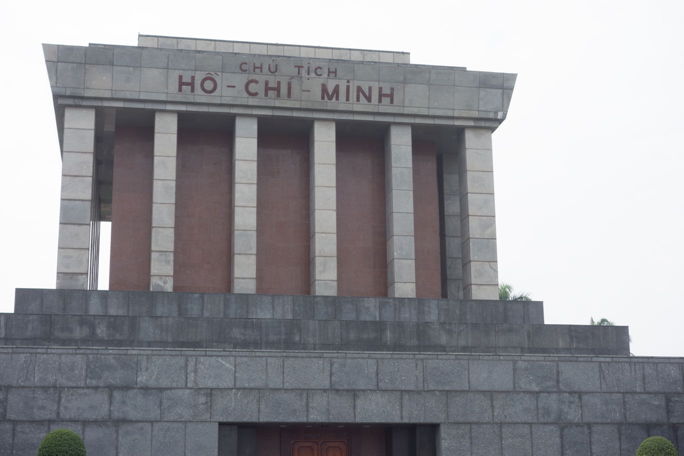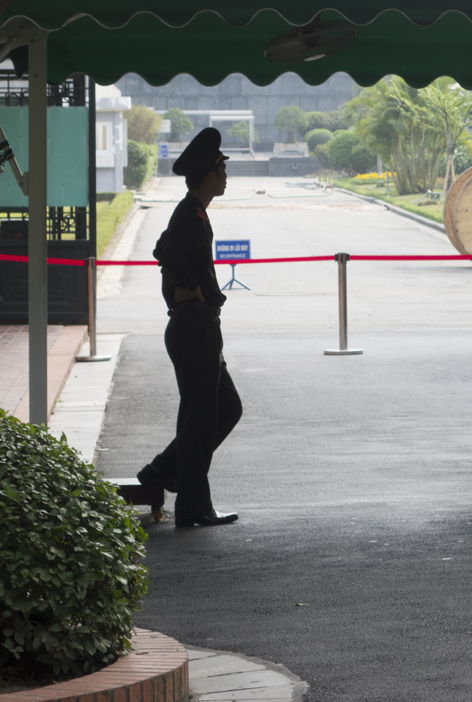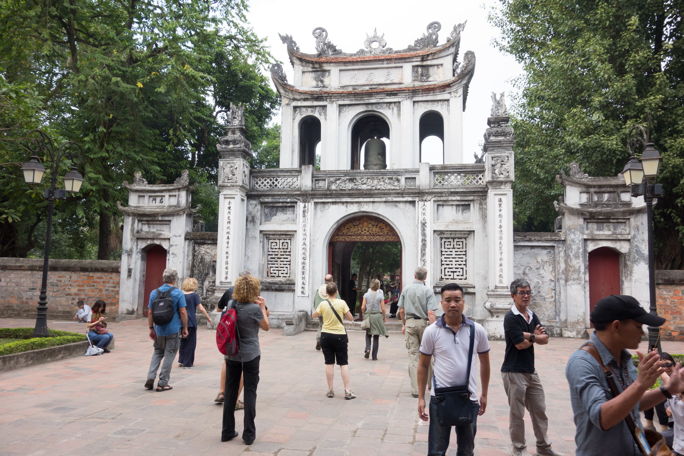
the government district of Hanoi. Beautiful. (Bigger image.)

|
|
The so beautiful and inspring Mausoleum for Ho Chi Minh in the government district of Hanoi. Beautiful. (Bigger image.) |
After lunch, we drove to the section where the government activities are concentrated. There are located the Parliament and other government buildings, but perhaps most important of all are the several buildings devoted to the memory of Ho Chi Minh.
He was the resistance leader, the deliverer of independence, and the founder of the state; you can easily see why he is honored by the people of his country. And much of what we saw gave some feeling for how he lived. But I found the story of the disposal of his remains very sad.
Truong told us that it had been Ho’s wish that he would be cremated, in the Buddhist tradition, and that his ashes would be divided, to rest in several of the country’s regions. But on his death, his wishes were violated, and the massive mausoleum built, to house his embalmed and viewable body, just like Lenin’s. The great gray granite pile rises well above street level; the eyes rise to take it in, and they shudder. I suppose it didn’t help that the sky was overcast that day, but I found the totality dark, forbidding, unwelcoming. But who am I to say? Perhaps this was the memorial that he deserved, even though he did not want anything like it.
Opposite the Mausoleum is the Parliament building, not terribly beauiful either, but not offensive. In the same complex is the Presidential Palace, elegant French fin-de-siècle architecture, but evidently too rich for Ho’s blood, and he much preferred the stilt house that he had built for him.

|
| Bored guard or soldier (bigger version). |
Next was a tourist sight that Truong felt we should see, the One-Pillar Pagoda. And I duly photographed it, the result to be seen at the right. The ever-reliable Wikipedia tells us that it’s almost a thousand years old, except that the French forces destroyed it at the time of their withdrawal from Vietnam, and what we see is a restoration. Maybe not so different from the situation in Japan, where temples are restored piece by piece as the wood rots.

|
| The street entrance to the Temple (bigger version). |
Last stop of the afternoon was the Temple of Literature, a thousand-year-old Confucian establishment out of which was born the Imperial Academy (Guozijian). This operated from 1076 to 1779, not a bad longevity for any school. The temple seemed to me to be the ultimate representation of Confucian ideals: that scholarship (in what we would call humanities, I think) is the highest possible calling for a well-bred person, and the only possible qualification for public office.
Maybe this is the place to express appreciation to Truong for his explanation of Vietnamese culture and history. In particular, the influence of Confucianism on the culture. If I remember correctly, he said that he would want to honor his family by improving his learning as much as possible. Not so strange, from our point of view. But he also pointed out that he allowed the nail of the fifth finger of his left hand to grow, and he manicured it carefully. Not for pulling wax out of his left ear, he repeatedly told us. Rather it seemed to be a symbolic act to remind him to pay attention to study — the improvement that would let him get a better job. He was obviously very proud of his single manicured nail. (While getting on a plane out of Vietnam, I saw another man with just such a fingernail, so Truong was not a loner in this practice.)
|
I couldn’t get the whole stele into the camera’s frame, so I
made this 18-second video clip to show how the stele rests on a turtle’s back, and how high it is. Truong’s comment accompanies. |
Within the precinct of the Temple, there were a number of “scholars’ stelai”, explained in the upper picture to the left. I think it will be quite readable in the large version. (“Van Mieu-Quoc Tu Giam” is the proper title of the Temple of Literature.) Anyway, they’re a kind of honor roll of scholars, whose achievements were considered worthy of memorialization in perpetuity. Note that everything is in Chinese characters; I’m not at all sure, but I think the language is the Vietnamese of the period, but using a specialized character for each syllable. I tried to find a description of the old writing method, but was unsuccessful. Of course the current method, using heavily marked-up Latin letters, dates from the days of French domination of the country. (Vietnamese and Chinese are not closely-related languages — not even in the same family.)
| Several young women in ao dai — 12-second clip. |
But that’s not all there was to see at the Temple of Literature — it was a great place to do people=watching. I think these were the days before students’ graduation, and there were a lot of young people wandering around in cap and gown. And many of the young women were wearing ao dai, but (unusually) all in similar colors, as if maybe this would be their graduation garb.
In spite of what I say above, I took remarkably few pictures of people there at the Temple of Literature; and unfortunately, I took no pictures either of the Temple proper. I did go inside, though, and got some shots of two of the four Confucian worthies who are honored there. Note, in the picture to the left, the boxes of offerings for the gentlemen. Are those edibles, or what?
We had done so much in this first day that we were much in need of a shower and rest — or at least I was. So we motored back to the hotel, and after the above decompression, we prepared for the evening’s activities. But to know about that, you must go to the next page.